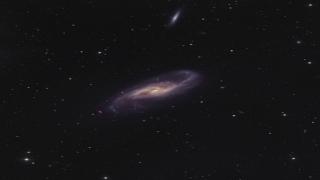Trujillo, I.; Martinez-Valpuesta, Inma; Martínez-Delgado, David; Peñarrubia, Jorge; Gabany, R. Jay; Pohlen, Michael
Referencia bibliográfica
The Astrophysical Journal, Volume 704, Issue 1, pp. 618-628 (2009).
Fecha de publicación:
10
2009
Revista
Número de citas
24
Número de citas referidas
22
Descripción
We have conducted a deep multiwavelength analysis (0.15-160 μm) to
study the outer region of the nearby galaxy M94. We show that the
non-optical data support the idea that the outskirts of this galaxy are
not formed by a closed stellar ring (as traditionally claimed in the
literature) but by a spiral arm structure. In this sense, M94 is a good
example of a Type III (anti-truncated) disk galaxy having a very bright
outer disk. The outer disk of this galaxy contains ~23% of the total
stellar mass budget of the galaxy and contributes ~10% of the new stars
created showing that this region of the galaxy is active. In fact, the
specific star formation rate (SFR) of the outer disk (~0.012
Gyr-1) is a factor of ~2 larger (i.e., the star formation is
more efficient per unit stellar mass) than in the inner disk. We have
explored different scenarios to explain the enhanced star formation in
the outer disk. We find that the inner disk (if considered as an oval
distortion) can dynamically create a spiral arm structure in the outer
disk which triggers the observed relatively high SFR as well as an inner
ring similar to what is found in this galaxy.
Proyectos relacionados

Huellas de la Formación de las Galaxias: Poblaciones estelares, Dinámica y Morfología
Bienvenida a la página web del g rupo de investigación Traces of Galaxy Formation. Somos un grupo de investigación amplio, diverso y muy activo cuyo objetivo principal es entender la formación de galaxias en el Universo de una manera lo más completa posible. Con el estudio detellado de las poblaciones estelares como bandera, estamos constantemente
Anna
Ferré Mateu

Las Galaxias Espirales: Evolución y Consecuencias
Nuestro grupo pequeño esta bien conocido y respetado internacionalmente por nuestro trabajo inovativo e importante en varios aspectos de la estructura y la evolución de las galaxias espirales cercanas. Usamos principalmente observaciones en varias longitudes de onda, explotando las sinergías que nos permiten responder a las cuestiones más
Johan Hendrik
Knapen Koelstra